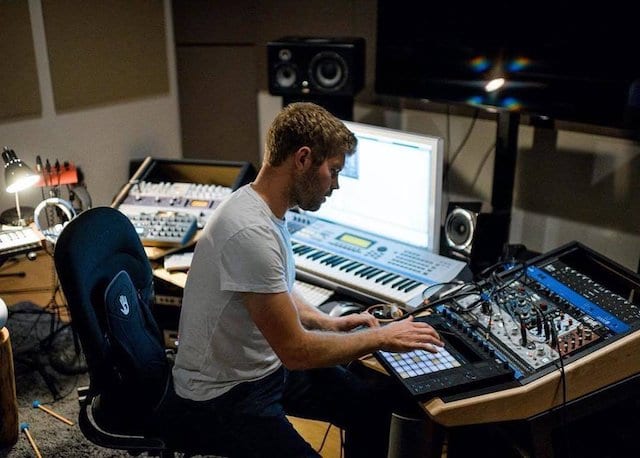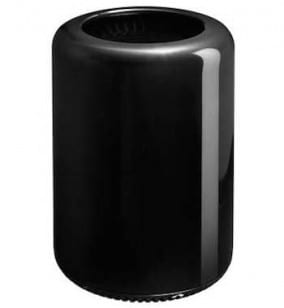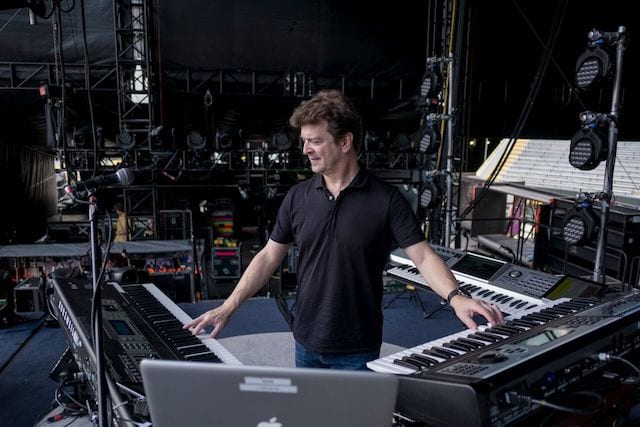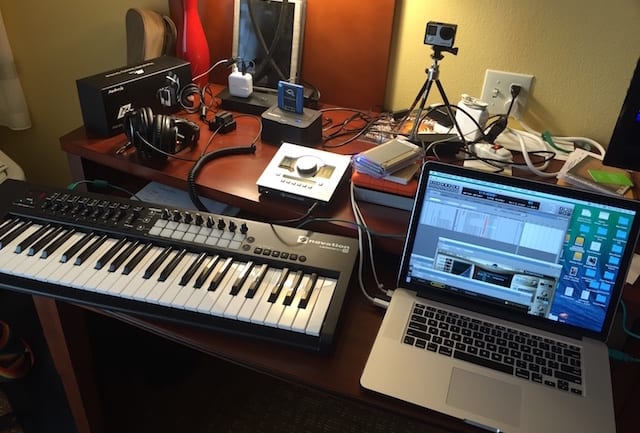
Grammy-nominated DJ/Producer and OWC Ambassador Morgan Page has made a career pushing the boundaries of new technologies both inside and outside of the studio where he creates chart-topping dance music. In this guest article, Page outlines the best options for music producers who are in need of more power for their studio rig.
For 20 years I’ve built music studios – integrating new advances in technology as things changed dramatically from software-based “trackers” w/ 8-bit samplers, to hardware samplers and synths in MIDI only setups, to hardware DSP, to native software setups, and now back to a mix of software and external hardware. It’s challenging to keep up without wasting money and time, so I’ve assembled some tips below to help when it’s time to upgrade your studio setup. Do you buy a new machine or hot-rod the existing setup? Let’s explore.
Modern Power
Processing power is a huge part of any music studio’s workflow. Plugins and soft-synths are more powerful than ever, but higher quality plugins are more DSP intensive – especially those that model high end analog signal processing, amps, and effects. Now that computers are smaller in size and denser in their configurations, they are much more difficult, if not impossible to upgrade due to components soldered and sandwiched together. This causes computers to run hotter, cost more to upgrade at the factory, and are limited in their customization because of fixed configurations. Since the majority of Apple’s focus is on general consumers with a 2-year product cycle, there are much longer cyclesfor the pro products (the last Mac Pro was updated five years ago) so it’s important to choose wisely.
Upgrade Options
Let’s say you are running out of processing power in your digital audio workstation (DAW), and it’s holding you back in your sessions. How do you navigate the process of upgrading your existing setup, versus buying an entirely new one? How do the costs stack up, and what smaller upgrades might make a bigger difference? In order to decide, it’s important to figure out what is lacking. Is it mainly CPU power? Or do you need faster SSDs for running apps, a faster transfer system for doing long-term backup, or are you running out of memory with virtual instruments? The most important first step is identifying your needs and then choosing the right path.
Before the Gear
Before you pull out your wallet, there are a number of steps you can take to improve performance. Reduce voice counts on soft synths, delete redundant tracks that are sonically masking each other, remove processing that isn’t contributing, revise your templates, clear out unused apps, plugins, and unused files on your hard drive. Opt for selective-synch cloud storage, where you can specify which files are stored locally or only in the cloud. Duplicate tracks, freeze both, then flatten one to consolidate. Always save your MIDI files. Bounce stems down for greater overall clarity and less CPU load, just be aware of sidechain processing and dependent racks that are triggering gates and compressors and can’t be frozen. You can always move the sidechain processing to the busses for easier automation. Double check your limiters and see if you need to have oversampling enabled, since that increases the CPU use. After you’ve done all that, it’s time to improve your existing setup with upgrades.
Improving Your Existing Setup
After taking some strategic steps to improve your sessions, take a look at your existing setup – how old is your laptop or tower? Since upgrading the CPU is often tricky and expensive, the first place to start is making sure you have an internal SSD with at least 1TB of space. Keep this in check with selective sync cloud storage, and keep a large fast external SSD for sample libraries and virtual instrument libraries, like an OWC ThunderBlade. Legacy backups don’t really have to be SSD, but it’s nice to have that performance. I use an OWC ThunderBay 4 RAID. There are several small footprint SSD options for external storage that can be attached with Velcro to the back of your laptop for easy mobile sessions, alongside your iLoks and e-licensors.
Upgrade and Offload
 After those steps, max out the memory. I put 128GB of OWC RAM into my 2013 Mac Pro and it’s made a huge difference with running virtual instruments like Omnisphere and Keyscape. Even after all these steps, you’re gonna need extra juice for dynamic processing and effects, especially for those final mastering stages. One of the best options is offloading some of the heavy lifting to external DSP like UAD, Waves Digigrid, or Avid HDX. The downside is that most music producers use a variety of plugin brands, and these are brand specific – Waves Digigrid won’t let you mix and match plugins within their interface and Avid HDX has limited development of their AAX DSP plugins. Universal Audio is a great option especially as their plugins cover a wide variety of brands and Auto-Tune is now supported, which is a huge performance gain for large track counts on vocal sessions. The UAD Satellite Octo is a great solution for a high performance setup with a laptop while travelling, since it has a small footprint – while the options from Waves and Avid require larger a large chassis and server rack. You can daisy chain up to six UAD Satellite Octos for tons of power. I use an Apollo Twin and Satellite Octo in my home studio setup, and I often bring the Octo on the road with my MacBook Pro to power sessions that would never be able to run natively on my laptop.
After those steps, max out the memory. I put 128GB of OWC RAM into my 2013 Mac Pro and it’s made a huge difference with running virtual instruments like Omnisphere and Keyscape. Even after all these steps, you’re gonna need extra juice for dynamic processing and effects, especially for those final mastering stages. One of the best options is offloading some of the heavy lifting to external DSP like UAD, Waves Digigrid, or Avid HDX. The downside is that most music producers use a variety of plugin brands, and these are brand specific – Waves Digigrid won’t let you mix and match plugins within their interface and Avid HDX has limited development of their AAX DSP plugins. Universal Audio is a great option especially as their plugins cover a wide variety of brands and Auto-Tune is now supported, which is a huge performance gain for large track counts on vocal sessions. The UAD Satellite Octo is a great solution for a high performance setup with a laptop while travelling, since it has a small footprint – while the options from Waves and Avid require larger a large chassis and server rack. You can daisy chain up to six UAD Satellite Octos for tons of power. I use an Apollo Twin and Satellite Octo in my home studio setup, and I often bring the Octo on the road with my MacBook Pro to power sessions that would never be able to run natively on my laptop.
Buying an entirely new computer
The biggest issue with a new Mac? Upgrades aren’t even possible – everything will need to be external, until the rumored 2019 modular Mac Pro is released. The main problem with maxing out the machine at the factory is you are paying top dollar for drives, memory, and processing. Buying 128GB of memory from OWC is $880 (as of this article’s publishing) versus $2,400 from Apple. The newest top of the line MacBook Pro is $6,700, because of the $3,200 cost to upgrade the 512GB SSD to 4TB drive. It doubles the cost of the entire laptop. I would advise just getting a 1 or 2TB system drive and save your money for a fast external SSD with a small footprint. You can buy an external OWC SSD 4TB for $1800. You’ll also need adapters for older Thunderbolt connections, or a Thunderbolt hub.
So what option is best for you? Probably a combination of multiple small hardware upgrades to your existing computer, and offloading DSP from select plugins to a device like the UAD Satellite. You might find diminishing returns with the processing on the latest MacBook Pros for music DAWs. Hold out as long as you can before buying new hardware, especially since compatibility is often an issue with OS versions and connectivity standards like Thunderbolt. It’s never a good idea to rush into new hardware and OS upgrades before the bugs have been squashed by developers. I typically like to wait at least 6 months until everything is stable and working. The investment in your setup will be well worth the money, just make sure to define exactly what you need. Good luck and have fun!
For more tips from Morgan Page, visit: mpquicktips.com!
• Grammy-nominated DJ/Producer and OWC Ambassador Morgan Page is ubiquitous within the dance music scene – his latest album, DC to Light (2015) features “Running Wild” and “Open Heart” and debuted at #1 on the Billboard Heatseekers chart and #3 on Dance/Electronic Albums chart.








